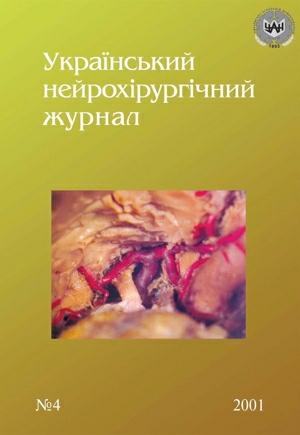Intraoperative cerebral blood flow monitoring during carotid endarterectomy
Keywords:
carotid artery surgery, intraoperative monitoring, DopplerAbstract
The results of stump pressure and middle cerebral blood flow velocity intraoperative monitoring in 75 patients during carotid surgery have been analized. The stump pressure ranged from 22 mm Hg till 85 mmHg. The author considers that critical level for patients with sustained completed stroke is 40 mm Hg. The worsening of the neurologic deficit occured in one case. Intraoprative middle cerebral blood flow velocity monitoring was made in 25 patients. The diminishing of the flow was registrated in 23 cases, but it didn’t reach the critical level. There was no postoperative complications in this group.Intraoperative monitoring during carotid surgery provides additional information regarding the cerebral circulation, helps to reduce the postoperative complications.References
Goldstein L.B., Hasselblad V., Matchar D.B., McCrory D.C. Comparison and meta-analysis of randomised trials of endarterectomy for symptomatic carotid artery stenosis // Neurology. — 1995. — V.45. — P.1965—1970.
European Carotid Surgery Trialists’ Collaborative Group. MRC European Carotid Surgery trial:interim results for results for symptomatic patients with severe (70—99%) or with mil mild (0—29%) carotid stenosis // Lancet. — 1991. —V.337. — P.1235—1243.
Warlow C.P. Symptomatic patients: the European Carotid Surgery Trial (ECST) // J. Mal. Vasc. — 1993. — V.18.— P.198—201.
Shah D.M., Darling C., Bock D.E.M., et al. Carotid endarterectomy in awake patients: Its safety, acceptability, and outcome // J.Vasc. Surg. — 1994. — V.19. — P.1015—1020.
Rockman C.B., Riles T.S., Gold M., et al. A comparison of regional and general anesthesia in patients undergoing carotid endarterectomy // J. Vasc. Surgery . — 1996. — V.24. — P.946—956.
Moore W.S., Hall A.D. Carotid artery back pressure: a test of cerebral tolerance to temporary clip occlusion // Arch. Surg. — 1969. — V.99. — P.702—710.
Cherry K.J.Jr., Roland C.F., Hallett J.W.Jr., et al. Stump pressure, the contralateral carotid artery, and electroencephalographic changes // Amer. Jour. of Surg. — 1991. — V.162, №2. — P.185—188.
Hobson R.W., Wright C.B., Sublett J.W., et al.. Carotid artery back pressure and endarterectomy under regional anesthesia // Arch. Surg. — 1973. — V.109. — P.682—687.
Rowed D.W., Vilaghy M.I. Intraoperative regional cerebral blood flow during carotid endarterectomy // Can. J. Neurol. Sci. — 1981. — V.8. — P.235—241.
Consensus Committee criteria of doppler microembolic signals. Basic identification criteria of doppler microembolic signals // Stroke. — 1995. — V.25. — P.1123.
Gerraty R.P., Bowser D.N., Infield B., et al. Microemboli during carotid angiography; association with stroke risk factors or subsequent MRI changes // Stroke. — 1996. — V.27. — P.1543—1547.
Finocchi C., Gandolfo C., Carissimi T., et al. Role of transcranial doppler and stump pressure during carotid endarterectomy // Stroke. — 1997. — V.28, №12. — P.2448—2452.
Spencer M.P. Transcranial doppler monitoring and causes of stroke from carotid endarterectomy // Stroke. — 1997. — V.28, №4. — P.685—691.
Downloads
How to Cite
Issue
Section
License
Copyright (c) 2001 Volodymyr Smolanka

This work is licensed under a Creative Commons Attribution 4.0 International License.
Ukrainian Neurosurgical Journal abides by the CREATIVE COMMONS copyright rights and permissions for open access journals.
Authors, who are published in this Journal, agree to the following conditions:
1. The authors reserve the right to authorship of the work and pass the first publication right of this work to the Journal under the terms of Creative Commons Attribution License, which allows others to freely distribute the published research with the obligatory reference to the authors of the original work and the first publication of the work in this Journal.
2. The authors have the right to conclude separate supplement agreements that relate to non-exclusive work distribution in the form of which it has been published by the Journal (for example, to upload the work to the online storage of the Journal or publish it as part of a monograph), provided that the reference to the first publication of the work in this Journal is included.









